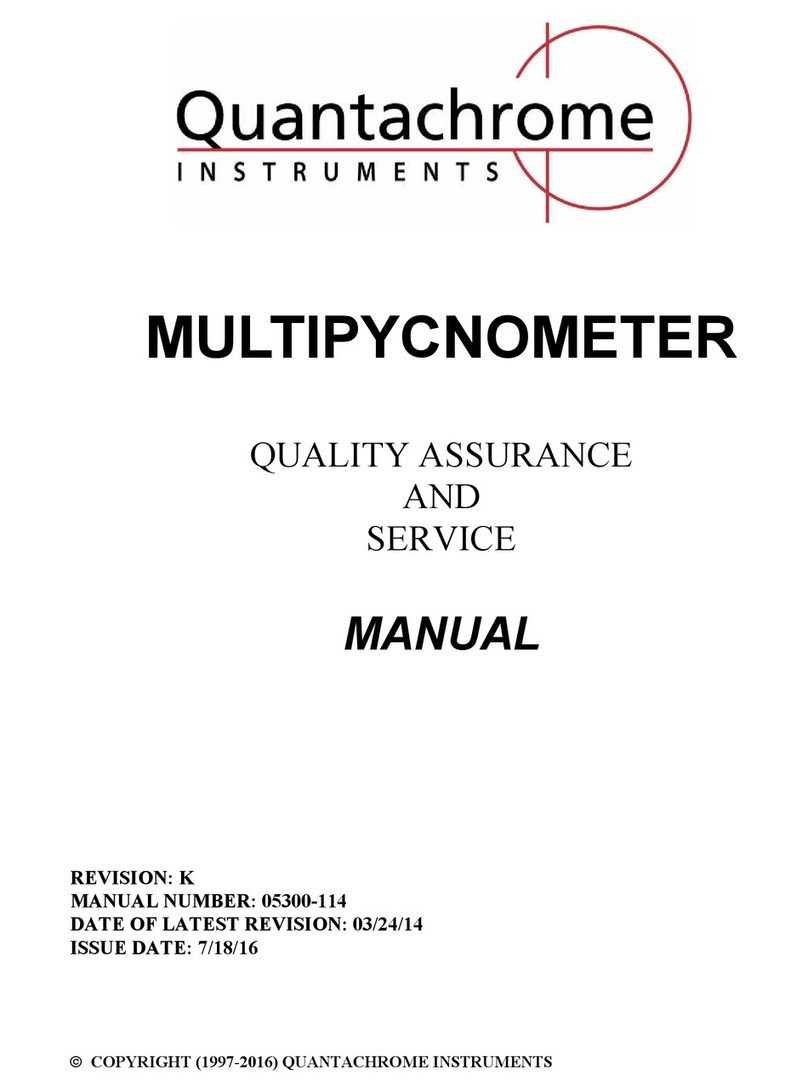
2
QUANTACHROME WARRANTY POLICY
Quantachrome Instruments warrants its instruments to be free from defects in material and workmanship for a
period of one year from date of shipment under normal use and conditions.
For the period commencing with the date of shipment and ending one year later, Quantachrome will, at its
option either repair or replace any part within an instrument that is found by us to be defective in material or
workmanship, without charge to the customer, at our facility or at a customer’s facility if the instrument
purchased is backed by Quantachrome’s on-site warranty as evidenced by the sales contract.
The customer is responsible for all transportation charges to our factory.
Damages during the warranty period resulting from unstable utilities, operator error or unauthorized repairs
will not be covered by this warranty.
Parts purchases are warranted to be free of defects for 90 days from shipping date.
The following limits apply to our warranty:
Glassware, including Dewar flasks, is not covered under this warranty except if damaged during shipment.
Claims for damage during shipping must be made in writing within 10 days of receipt of the goods.
Expendable items are warranted for 90 days for other than glassware breakage. Such items include, but are
not limited to, sample tubes, lamps, fuses, valve plungers, seals, o-rings & other seals, hoses, flexible tubing,
thermocouple vacuum tubes, filters, oils and other fluids.
Products sold by Quantachrome under their own brand name are not warranted by Quantachrome, but our best
effort will be made to secure repair or replacement if found to be defective.
Warranty becomes void in the event of modifications or repairs by persons other than Quantachrome’s service
personnel, unless permission is given in writing for such repairs or modifications. Warranty is also void in the
event of exposure to corrosive atmospheres of any kind.
Prior authorization must be obtained before returning any item to Quantachrome Instruments. Items must be
decontaminated before return to Quantachrome.
Any and all computer program(s), software, firmware, code, data acquisition and/or data reduction methods,
computations, graphical and/or tabular data reporting or presentation methods (collectively referred to as
software) provided with or in or loaded into any part of the instrument or a computer supplied as part of a
Quantachrome Instruments’ instrument are provided “as is”. Quantachrome Instruments warrants the
software will perform substantially in accordance with the accompanying materials for the period of this
warranty. All software is licensed and not sold. Quantachrome Instruments retains all rights to all software.
You may not reverse engineer, decompile, or disassemble the software. You may not distribute or copy the
software, except for the purpose of storing a back-up copy. The exclusive remedy for any software failing to
perform substantially in accordance with the accompanying materials shall be, at Quantachrome’s option, a)
repair or replacement of the software; b) return of the amount paid for the software. You are not entitled to
any damages, including but not limited to incidental, punitive, indirect or consequential damages including
but not limited to loss of profits, business interruption, personal injury, and other pecuniary losses.




























